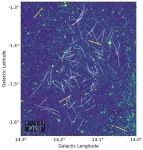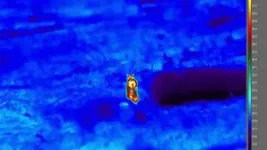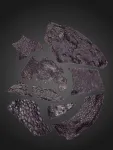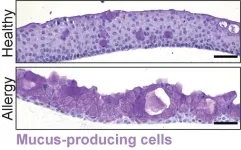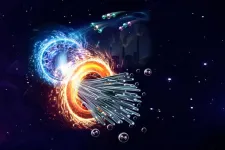(Press-News.org)
A team of astronomers including those from the University of Tokyo created the first-ever map of magnetic field structures within a spiral arm of our Milky Way galaxy. Previous studies on galactic magnetic fields only gave a very general picture, but the new study reveals that magnetic fields in the spiral arms of our galaxy break away from this general picture significantly and are tilted away from the galactic average by a high degree. The findings suggest magnetic fields strongly impact star-forming regions which means they played a part in the creation of our own solar system.
It might come as a surprise to some that magnetic fields can exist on scales larger than a planet. Most of our daily experience with magnetic fields involves either sticking things to our refrigerator, or perhaps using a compass to point north. The latter shows the existence of magnetic fields generated by our planet. Our sun also creates a vast magnetic field, and this can affect phenomena like solar flares. But magnetic fields that span the galaxy are almost too large to comprehend, and yet they likely have a role in the formation of stars and planets.
“Until now, all observations of magnetic fields within the Milky Way led to a very limited model that was uniform all over and largely matched the disc shape of the galaxy itself,” said Assistant Professor Yasuo Doi from the Department of Earth Science and Astronomy. “Thanks in part to telescope facilities at Hiroshima University capable of measuring polarized light to help us ascertain magnetic signatures, and the Gaia satellite launched by the European Space Agency in 2013, which specialized in measuring the distances to stars, we are able to build a better model with finer details in three dimensions. We focused on a specific area, the Sagittarius arm of our spiral galaxy (we are in the neighboring Orion arm) and found the dominant magnetic field there breaks away from the plane of the galaxy significantly.”
Previous models and observations could only imagine a smooth and largely homogeneous magnetic field in our galaxy; whereas the new data show that although magnetic field lines in the spiral arms do roughly align with the galaxy at large, at small scales the lines are actually spread out across a range of distances due to various astrophysical phenomena such as supernovae and stellar winds. The galactic magnetic fields are also incredibly weak, around 100,000 times weaker than Earth’s own magnetic field. Despite this, however, over long time spans, gas and dust in interstellar space are accelerated by these fields which explains the presence of some stellar nurseries — star-forming regions — that cannot be explained by gravity alone. This finding implies further mapping of the magnetic fields within our galaxy could help better explain the nature and evolution of the Milky Way and other galaxies too.
“I am personally intrigued by the foundational process of star formation, pivotal to the creation of life, including ourselves, and I aim to grasp this phenomenon in its entirety with time,” said Doi. “We aim to further our observations and build better models of galactic magnetic field structures. This endeavor aims to provide observational insights into the accumulation of gas fueling active star formation within our galaxy and its historical development.”
###
Journal article: Yasuo Doi, Kengo Nakamura, Koji S. Kawabata, Masafumi Matsumura, Hiroshi Akitaya, Simon Coude, Claudia V. Rodrigues, Jungmi Kwon, Motohide Tamura, Mehrnoosh Tahani, Antonio Mario Magalhaes, Reinaldo Santos-Lima, Yenifer Angarita, Jose Versteeg, Marijke Haverkorn, Tetsuo Hasegawa, Sarah Sadavoy, Doris Arzoumanian, and Pierre Bastien. “Tomographic Imaging of the Sagittarius Spiral Arm’s Magnetic Field Structure”, The Astrophysical Journal, DOI: 10.3847/1538-4357/ad0fe2
Funding:
This research has been supported by JSPS KAKENHI grants 25247016, 18H01250, 18H03720, 20K03276, and 20K04013. M.Tahani is supported by the Banting Fellowship (Natural Sciences and Engineering Research Council Canada) hosted at Stanford University and the Kavli Institute for Particle Astrophysics and Cosmology (KIPAC) Fellowship. CVR thanks the Brazilian Conselho Nacional de Desenvolvimento Científico e Tecnológico - CNPq (Proc: 310930/2021-9). AMM’s work and optical/NIR polarimetry at IAG have been supported over the years by several grants from the São Paulo state funding agency FAPESP, especially 01/12589-1 and 10/19694-4. AMM has also been partially supported by the Brazilian agency CNPq (grant 310506/2015-8).
Research contact:
Assistant Professor Yasuo Doi
Department of Earth Science and Astronomy, Graduate School of Arts and Sciences
The University of Tokyo, 3-8-1 Komaba, Meguro, Tokyo 153-8902, Japan
doi@ea.c.u-tokyo.ac.jp
Press contact:
Mr. Rohan Mehra
Public Relations Group, The University of Tokyo,
7-3-1 Hongo, Bunkyo-ku, Tokyo, 113-8656, Japan
press-releases.adm@gs.mail.u-tokyo.ac.jp
About The University of Tokyo
The University of Tokyo is Japan's leading university and one of the world's top research universities. The vast research output of some 6,000 researchers is published in the world's top journals across the arts and sciences. Our vibrant student body of around 15,000 undergraduate and 15,000 graduate students includes over 4,000 international students. Find out more at www.u-tokyo.ac.jp/en/ or follow us on X (formerly Twitter) at @UTokyo_News_en.
END
Researchers have identified a 3D fragment of fossilized skin that is at least 21 million years than previously described skin fossils. The skin, which belonged to an early species of Paleozoic reptile, has a pebbled surface and most closely resembles crocodile skin. It’s the oldest example of preserved epidermis, the outermost layer of skin in terrestrial reptiles, birds, and mammals, which was an important evolutionary adaptation in the transition to life on land. The fossil is described on January 11 in the journal Current Biology along with several other specimens that were collected from the Richards Spur ...
The Organoid group at the Hubrecht Institute produced the first organoid model of the human conjunctiva. These organoids mimic the function of the actual human conjunctiva, a tissue involved in tear production. Using their new model, the researchers discovered a new cell type in this tissue: tuft cells. The tuft cells become more abundant under allergy-like conditions and are therefore likely to play a role in allergies. The organoid model can now be used to test drugs for several diseases affecting the conjunctiva. The study will be published in Cell Stem Cell on 11 January 2024.
Our eyes produce tears to protect themselves from injuries and ...
A new species of tyrannosaur from southern North America that may the closest known relative of Tyrannosaurus rex is described in a study published in Scientific Reports.
Sebastian Dalman and colleagues identified the new species — which they have named Tyrannosaurus mcraeensis — by examining a fossilised partial skull, which was previously discovered in the Hall Lake Formation, New Mexico, USA. Although these remains were initially assigned to T. rex and are comparable in size to those of T. rex (which was up to 12 metres long), the authors propose that they belong to a new species due ...
MIAMI, FLORIDA (EMBARGOED UNTIL JAN. 11, 2024, at 11 AM EST) – Certain cancers are more difficult to treat because they contain cells that are highly skilled at evading drugs or our immune systems by disguising themselves as healthy cells.
Glioblastoma, for example, an incurable brain cancer, is characterized by cells that can mimic human neurons, even growing axons and making active connections with healthy brain neurons. This cancer is usually deadly – average survival time is just over one year from diagnosis ...
A new study led by researchers from the UCLA Health Jonsson Comprehensive Cancer Center shows that using high doses of radiation while integrating an ablative radiotherapy technique called stereotactic ablative radiotherapy (SABR) concurrently with chemotherapy is safe and effective in treating people with locally advanced non-small cell lung cancer that is not suitable for surgery.
Based on mid-treatment response, researchers found the combination treatment, which involves a second radiation plan to personalize a boost for the last third of radiation treatments, is a viable and promising option that helps reduce the risk of toxic side effects and having the cancer ...
Whether picking up a small object like a pen or coordinating different body parts, the cerebellum in the brain performs essential functions for controlling our movement. Researchers at the Institute of Science and Technology Austria (ISTA) investigated how a crucial set of synapses between neurons within it functions and develops. Their findings have now been published in the journal Neuron.
Even if you do not think about it, every day you are using the intricate circuits of neurons in your brain to perform astonishingly delicate movements with your body. One essential unit in this is the cerebellum playing a key role in fine motor control, coordination, and timing.
“Every ...
UPTON, NY—Scientists at the U.S. Department of Energy’s (DOE) Brookhaven National Laboratory and Columbia University have developed a way to convert carbon dioxide (CO2), a potent greenhouse gas, into carbon nanofibers, materials with a wide range of unique properties and many potential long-term uses. Their strategy uses tandem electrochemical and thermochemical reactions run at relatively low temperatures and ambient pressure. As the scientists describe in the journal Nature Catalysis, this approach could successfully lock carbon away in a useful solid form to offset or even achieve negative carbon emissions.
“You can put the carbon nanofibers ...
About The Study: The findings of this study of 6,101 adult cancer survivors suggest that substance use disorder (SUD) prevalence is higher among survivors of certain types of cancer; this information could be used to identify cancer survivors who may benefit from integrated cancer and SUD care. Future efforts to understand and address the needs of adult cancer survivors with comorbid SUD should prioritize cancer populations in which SUD prevalence is high.
Authors: Devon K. Check, Ph.D., of the Duke University School of Medicine in Durham, North Carolina, is the corresponding author.
To access the ...
About The Study: In this study of patients diagnosed with head and neck cancer from 2017 to 2020 in the U.S., the incidence of localized head and neck cancer declined during the first year of the pandemic. A subsequent increase in advanced-stage diagnoses may be observed in later years.
Authors: Nosayaba (Nosa) Osazuwa-Peters, B.D.S., Ph.D., M.P.H., C.H.E.S., of the Duke University School of Medicine in Durham, North Carolina, is the corresponding author.
To access the embargoed study: Visit ...
A new, systematic analysis of cancer cells identifies 370 candidate priority drug targets across 27 cancer types, including breast, lung and ovarian cancers.
By looking at multiple layers of functional and genomic information, researchers were able to create an unbiased, panoramic view of what enables cancer cells to grow and survive. They identify new opportunities for cancer therapies in a significant leap towards a new generation of smarter, more effective cancer treatments.
In the most comprehensive study of its kind, researchers ...
